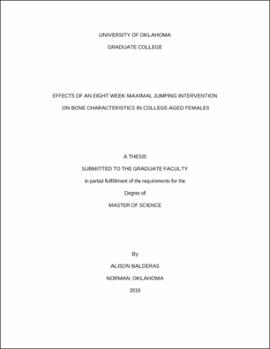| dc.description.abstract | Peak bone mass occurs between the second and third decade, around a person’s late twenties and is followed by a plateau in bone mineral density (BMD). Osteoporosis can be a result from a failure to achieve peak bone mass (Forwood, 2013a). Although there is a time delay, exercise has shown to have positive effects on bone accrual and to alter bone geometry and density (Reiger & Yingling, 2016). Longitudinal jump interventions have been shown to increase BMD of the femoral neck and lumbar spine in college-aged females. Purpose: The purposes of this study were to: (1) compare bone mineral density before and after an eight-week low-repetition, high-impact loading jump intervention in premenopausal women between the ages of 18-24, (2) compare bone geometry before and after the intervention to determine alterations, and (3) compare cross-sectional area of the muscle in the lower limb before and after the intervention. Methods: Twenty healthy college-aged females were randomly assigned to a control group or a jump intervention group for the eight-week intervention. Body composition and areal bone mineral density (aBMD) measurements were analyzed using dual energy x-ray absorptiometry (DXA). Peripheral quantitative computed tomography (pQCT) was utilized to measure volumetric bone mineral density (vBMD) of the 4%, 38%, and 66% sites of the nondominant tibia. Jump power and velocity were measured using the Tendo FiTRODYNE power and speed analyzer while jump height and airtime were measured using a Just Jump mat. All tests were measured at the beginning of the study (pre-test) and again eight-weeks later for the post-test. The jump variables were also measured at the four-week time-point (mid-test). The control group was instructed to continue their lives without increasing their physical activity for the eight-week duration of the study. The intervention group engaged in ten maximal countermovement jumps five days per week for the first two weeks of the study, and increased their jumps by five every two weeks (jumping 15, 20, and 25 times). Independent t-tests were run to compare the control group to the intervention group for all dependent variables at baseline. Two-way repeated measures ANOVA (group x time) were run to compare the group differences in changes in the dependent variables from pre to post intervention. Percent changes in variables were analyzed by independent t-tests (group) or two-way repeated measures ANOVA (group x time) depending on if the dependent variables had one or two time points. Results: There were no significant differences in physical characteristics, DXA bone variables or pQCT bone variables, between the two groups at baseline. There were no significant group, time, or group x time effects for any of the bone or body composition variables assessed by DXA. There were significant time effects for the cross-section moment of inertia and section modulus as both groups decreased over time. No significant group, time, group x time effects were found for pQCT variables at the 4% or 38% site of the nondominant tibia. However, significant group x time effects were found for the vBMD of the 66% site of the nondominant tibia and significant time effects were found for total BMC and cortical BMC. Conclusion: The jump intervention did not increase DXA variables, 4% and 38% pQCT variables, or jump variables in this cohort of young women. There was a group x time effect on the vBMD of the 66% site of the nondominant tibia. Future studies should focus on a longer intervention to provide time for bone formation to begin. Additionally, recruiting a larger sample size would provide a greater statistical power. Future studies could also increase the intensity of the intervention throughout the duration by using weighted vests or utilizing drop jumps. | en_US |
